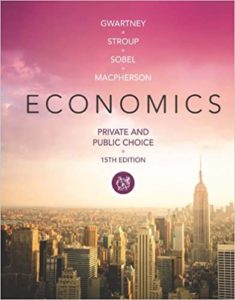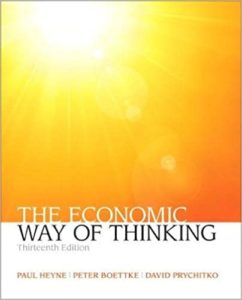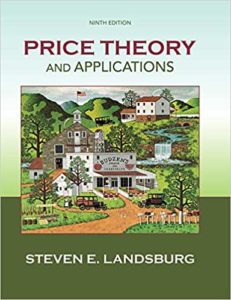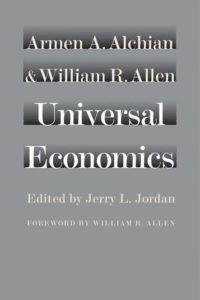Price Theory and Principles Textbooks
Alchian, Armen and Allen, William, Universal Economics
Universal Economics shows the critical importance of property rights to the existence and success of market economies. The authors explain the interconnection between goods prices and productive-asset prices and how market-determined interest rates bring about the allocation of resources toward the satisfaction of consumption demands versus saving/investment priorities. They show how the crucial role of prices in a market economy cannot be well understood without a firm grasp of the role of money in the modern world. The Alchian and Allen application of information and search-cost analysis to the subject of money, price determination, and inflation is unique in the teaching of economic principles.
Alchian, Armen and Allen, William, Exchange and Production: Theory in Use
This book is a classic of modern economics education. If you are looking for an introduction to economics that will entertain without shying from important delicate issues, this book is just the ticket. Samuelson’s Principles may have been the source from which thousands of non-economists learned college economics for over a decade; but Alchian and Allen was the book from which thousands of academic economists got their first inspiration. Yes, there are some graphs, some tables, and some simple equations; but the examples and problem sets are replete with exciting questions that continue to motivate and challenge students to go further in economics.
Becker, Gary, Economic Theory
No list of price theory textbooks would be complete without this influential book based on Becker’s lectures. However, it is not for the faint of heart. But, if you prefer to just have the material laid out in the form of power-packed, succinct explanations and their associated equations, from algebraic to calculus, this book has exactly the right stuff. (Plus, the discovery that in one instance Gary Becker has two pages of calculations to do what ought to be no more than a three-line proof has motivated many a graduate student with pride.) And, those succinct explanations really do contain some of the most clear explanations extant, which is a joy that accompanies getting the mathematical nuances.
Friedman, David, Price Theory: An Intermediate Text
David Friedman’s textbook is an excellent choice for a first introduction to the economic way of thinking for someone with no economics background. Written with a light touch, and full of entertaining and innovative examples, this book is fun to read, and full of perfectly worded explanations of even the most complex and subtle economic ideas. A highly motivating book. The online version is the complete second edition, with the addition of two chapters from the first edition that did not appear in the printed second edition.
Friedman, Milton, Price Theory
Milton Friedman‘s book is a classic in graduate school education. It is one of the few graduate textbooks to present clear graphical and verbal explanations of income and substitution effects, and one of the first textbooks to talk about expected utility, the basis of rational expectations. It’s not an introduction for someone who is not motivated or is not interested in equations and graphs to clarify the details, though.

Gwartney, James and Richard Stroup, Economics: Public and Private Choice
One of few textbooks with more emphasis on government failure than market failure, it dispels common economic myths. The text uses the “invisible hand” metaphor to explain economic theory, demonstrating how it works to stimulate the economy. The latest edition includes analysis and explanation of measures of economic activity in today’s market. It also includes highlights of the recession of 2008-2009, and an in-depth look at the lives and contributions of notable economists.

Heyne, Paul; Boettke, Peter; and Prychitko, David, The Economic Way of Thinking
Most beginning texts in economics have become encyclopedias that go on for a thousand or more pages and introduce the student to a countless number of different topics with what seems to be an endless series of diagrams. The result is that most students come away convinced that economics is lots of pain with little gain, and have not the foggiest notion of the few basics that are essential to economic literacy. Heyne’s book has gotten a bit longer over successive editions, but is still less than half as long as most principles text. But more important is that Heyne emphasizes the basics, applies them to a few issues, keeps the diagrams simple and relatively few, and follows up each chapter with a long list of “Questions for Discussion” that show how economics applies to a host of everyday activities. And the clear exposition, with a comfortable conversational quality, makes the book a pleasure to read. The Economic Way of Thinking is a bona fide economics textbook, but one that recognizes that sometimes students can get more with less.
Hirshleifer, Jack and David Hirshleifer, Price Theory and Applications
This excellent book is the standard from which most current economists learned the meat of economics before going on to higher level courses. Clearly written, well organized, refined by many years of improvements, and full of time-tested explanations and examples, it’s a classic among textbooks.

Landsburg, Steven, Price Theory and Applications
This fine, widely used textbook contains entertaining examples and clear explanations with a minimal emphasis on equations. The coverage is thorough, graphical, and with a consistent tone throughout the book. This is an excellent choice for someone who has had no economics background but wants to get a feeling of excitement for what economics is really about.
Stigler, George, The Theory of Price
A classic in graduate school education that is in fact written clearly enough to be readable by a motivated college student. It is one of the few textbooks to present truly clear graphical, table, and verbal explanations of production, including short and long run cost curves, average and marginal cost, and marginal productivity theory. It’s not an introduction for someone who is not motivated or is not interested in graphs or reading through a few tables for the details, but it’s the perfect view for someone looking to clarify puzzles about production that are not clearly explained in other introductory texts.
Some Classics
Marshall, Alfred, Principles of Economics, 8th edition
Menger, Carl, Principles of Economics
Mill, John Stuart, Principles of Political Economy, Ashley edition.
Ricardo, David, On the Principles of Political Economy and Taxation
Say, Jean-Baptiste, A Treatise on Political Economy
Senior, Nassau W., Political Economy
Smith, Adam, An Inquiry into the Nature and Causes of the Wealth of Nations, Cannan edition.
Wicksteed, Philip H., The Common Sense of Political Economy


